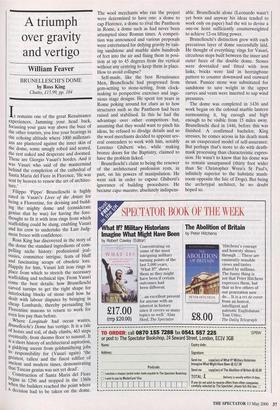A triumph over gravity and vertigo
William Feaver BRUNELLESCHI'S DOME by Ross King
Chatto, £15.99, pp. 184 It remains one of the great Renaissance experiences. Jamming your head back, focussing your gaze way above the buzz of the other tourists, you lose your bearings in the echoing altitude where 1000 millenari- ans are plastered against the inner skin of the dome, some smugly robed and seated, the rest naked and desperate and doomed. These are Giorgio Vasari's hordes. And it was Vasari who said of the mastermind behind the completion of the cathedral of Santa Maria del Fiore in Florence, 'He was sent by heaven to renew the art of architec- ture.'
Filippo 'Pippo' Brunelleschi is highly rated in Vasari's Lives of the Artists for being a Florentine, for devising and build- ing the mighty dome and (considerate genius that he was) for having the fore- thought to fit it with iron rings from which scaffolding could be slung, enabling Vasari and his crew to undertake the Last Judg- ment fresco with confidence.
Ross King has discovered in the story of the dome the standard ingredients of com- pelling niche history: professional jeal- ousies, committee intrigue, feats of bluff and fascinating scraps of obsolete lore. Happily for him, Vasari left iron rings in Place from which to stretch the necessary scaffolding and technical tips. From Vasari come the best details: how Brunelleschi carved turnips to get the right shape for interlocking blocks of stone and how he dealt with labour disputes by bringing in cheap Lombards, thereby persuading his Florentine masons to return to work for even less pay than before. Where Longitude had ocean wastes, Brunelleschi's Dome has vertigo. It is a tale of hoists and toil, of daily climbs, 463 steps eventually, from duomo floor to summit. It Is a short history of architectural aspiration, a giddying ascent from goldsmithying jobs to responsibility for (Vasari again) the greatest, tallest and the finest edifice of ancient and modern times, demonstrating that Tuscan genius was not yet dead'. , Construction of Santa Maria del Fiore began in 1296 and stopped in the 1360s When the builders reached the point where a decision had to be taken on the dome. The wool merchants who ran the project were determined to have one: a dome to cap Florence, a dome to rival the Pantheon in Rome, a dome such as had never been attempted since Roman times. A competi- tion was announced and various proposals were entertained for defying gravity by rais- ing sandstone and marble slabs hundreds of feet into the air and fixing them in posi- tion at up to 45 degrees from the vertical without any centring to keep them in place. How to avoid collapse?
Self-made, like the best Renaissance Men, Brunelleschi had progressed from gem-setting to stone-setting, from clock- making to perspective exercises and inge- nious stage designs. He spent ten years in Rome poking around for clues as to how structures such as the Pantheon had been raised and stabilised. In this he had the advantage over other competitors but, assuming that they would want to pinch his ideas, he refused to divulge details and so the wool merchants decided to appoint sev- eral contenders to work with him, notably Lorenzo Ghiberti who, while making bronze doors for the Baptistry, claimed to have the problem licked.
Brunelleschi's claim to being the renewer of the architectural profession rests, in part, on his powers of manipulation. He went sick in order to expose Ghiberti's ignorance of building procedures. He became capo maestro, absolutely indispens- able. Brunelleschi alone (Leonardo wasn't yet born and anyway his ideas tended to work only on paper) had the wit to devise a one-ox hoist sufficiently counterweighted to achieve 12-ox lifting power.
Brunelleschi's distinction grew with each precarious layer of dome successfully laid. He thought of everything: rings for Vasari, circuitous steps built between the inner and outer faces of the double dome. Stones were dovetailed and fitted with iron links, bricks were laid in herringbone pattern to counter downward and outward thrust. Pumice stone was substituted for sandstone to save weight in the upper curves and vents were inserted to sap wind pressures.
The dome was completed in 1436 and work began on the colossal marble lantern surmounting it, big enough and high enough to be visible from 15 miles away. Brunelleschi died in 1446, before this was finished. A confirmed bachelor, King stresses, he comes across in his death mask as an exasperated model of self-assurance. But perhaps that's more to do with death- mask processing than characteristic expres- sion. He wasn't to know that his dome was to remain unsurpassed (thirty foot wider than Sir Christopher Wren's St Paul's, infinitely superior to the hubristic mush- room opposite the Isle of Dogs). But being the archetypal architect, he no doubt hoped so.


























































 Previous page
Previous page